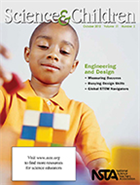Engineering and design
By Mary Bigelow
Posted on 2013-10-31
I’ve talked with teachers who are concerned about the E in STEM. “I barely have time for science, and now I’m supposed to teach engineering, too? I’ve never studied engineering!”
I think these teachers might feel a little more confident after reading the guest editorial The Next Generation Science Standards and Engineering for Young Learners: Beyond Bridges and Egg Drops. The article has a chart that compare science and engineering practices, and there are a lot of similarities. The fundamental difference seems to be that science asks questions while engineering defines problems. Many of the activities that are common in science classes are actually based on engineering problems.
In an earlier post Early education in engineering and design, Peggy Ashbrook looks at the engineering skills that even our youngest students bring with them. She provides insights, resources, and suggestions for building on these.
Beginning with the October issue, Science and Children has a new column called Engineering Encounters on teaching strategies to support teaching children how to design, explore the ways engineers conduct their work, and include ways in which lessons in engineering can be integrated with science. This month’s column explores some misconceptions students have. In another column, Safety First, Ken Roy reviews some safety precautions that should be considered during STEM activites.
Other featured articles focus on activities and design problems on flying machines, pendulums, weather forecasting, rockets, buoys, building projects, electromagnetic induction, and waterways. [SciLinks: Forecasting the Weather, Magnetic Fields, Engineering Structures, Pendulums, Rivers, Rockets]
Many of these articles have extensive resources to share, so check out the Connections for October 2103. Even if the article does not quite fit with your lesson agenda, there are ideas for handouts, background information sheets, data sheets, rubrics, and other resources.
Disclaimer: The views expressed in this blog post are those of the author(s) and do not necessarily reflect the official position of the National Science Teaching Association (NSTA).


